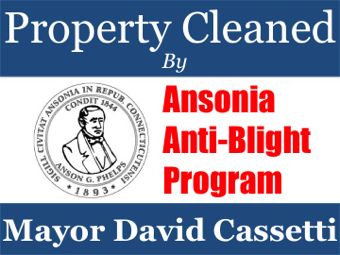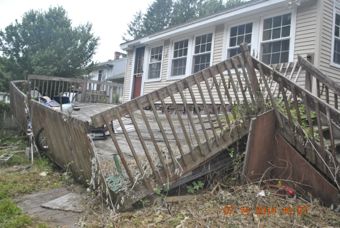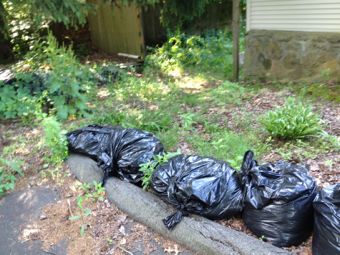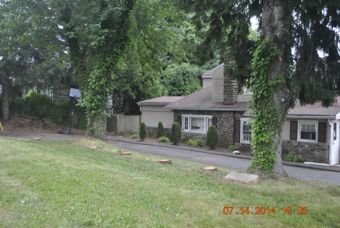 The battle against blight in the lower Naugatuck Valley is intensifying, with Derby exploring whether to adopt Ansonia’s self-described “Godzilla”-like anti-blight law.
The battle against blight in the lower Naugatuck Valley is intensifying, with Derby exploring whether to adopt Ansonia’s self-described “Godzilla”-like anti-blight law.
Specifically, Alderman Carmen DiCenso last month gave his fellow Derby Aldermen a copy of Ansonia’s “clean and lien” policy.
Ansonia Alderman adopted an anti-blightl law in April, part of which allows the city to hire contractors to clean badly blighted properties — after giving the property owner fair warning and an opportunity to clean up the mess.
Ansonia Corporation Counsel John Marini said the policy has been effective. He the city has gone ahead and cleaned 15 properties since last spring.
The city only cleans the exterior of properties — cutting grass, removing trash and other junk, getting rid of out-of-control shrubs, that sort of thing.



Marini pointed to “before and after” photos showed to the Valley Indy recently with Dave Blackwell, Sr., Ansonia’s blight officer/zoning enforcement officer.
The transformation of a property on Ford Street was probably the most impressive. Blackwell was contacted by neighbors who said a foul smell was coming from the wildly overgrown property.
“They were afraid someone was dead in there,” Blackwell said.
He arrived to see lots and lots of garbage bags in the lawn — the source of the odor.
Long story short, the city brought in a landscaping crew to clean up the property. They even manicured the shrubs outside the house.
The property went from smelling like a rotting corpse to respectable within 15 days.
In Ansonia, the city initially pays to clean up the property — they have about $80,000 to use — then puts a lien on the property with the hope they’ll be able to get paid back.
The “clean and lien” is essentially two “penalties” Ansonia now uses to combat blight.
The other “penalty” is fining the blighted property’s owner — $100 per day for 30 days, after which the fine increases to $250 per day — until the property is cleaned up.
In terms of blight policy, “clean and lien” is a radical concept for Ansonia and Derby, two densely populated cities where rundown properties can wreak havoc on property values.
Blight is a hugely complicated issue to tackle, especially when it comes to abandoned properties with massive blight fines.
Fines sound great — but they’re hard to collect, especially if an owner abandons a property.
A fairly typical scenario sees a blighted property fall into foreclosure, a bank takes over, and then a new buyer steps up to purchase the property and take care of the blight problem.
But the fines stay with the property, and can actually become a hindrance to a new buyer.
It’s an issue that has caused various members of the Derby Board of Aldermen to bang their heads against the proverbial blighted wall for years.
Toward the end of Mayor Anthony Staffieri’s administration, Derby began foreclosing on some of the city’s worst problem properties.
However, the foreclosure process can drag on for years.
New Derby Mayor Anita Dugatto created a blight subcommittee of the Derby Board of Aldermen. DiCenso is the chairman of the subcommittee.
Derby was able to pressure the owner of a long-blighted abandoned property on Derby Avenue to tear it down in June.
Generally, municipalities have been extremely wary of sending town employees or town representatives onto blighted properties that don’t pose an immediate threat to health and safety.
But Marini said “clean and lien” programs have been popping up all over the country for awhile now. In Connecticut, Marini pointed to the City of New Britain as a model program.
Due process is followed, Marini said, and the blight officer works hand-in-hand with Marini to decide which properties are ideal “clean and lien” candidates.
 Case law in Connecticut doesn’t have a ton of challenges to “clean and lien” policies.
Case law in Connecticut doesn’t have a ton of challenges to “clean and lien” policies.
But Marini said there have been some court decisions outside the state that strengthen the city’s position to enter private property.
He pointed to a 2007 case in Maryland where a property owner claimed trespass and further alleged the government damaged his property.
“The court sided with the city and said that the due process requirements were met. Proper notice was given, the notice made clear what form the remediation would take and there was an opportunity to appeal,” Marini said. “The action was deemed not to be trespass.”
Marini said the Maryland case isn’t the definitive case, but an example of where a court sided with the government.
Here is an overview of Ansonia’s anti-blight program:
- Neighbors complain to the blight officer
- The blight officer looks at the property (a blight officer cannot go on your property without permission)
- The blight officer logs it as blight, if he thinks it is blight.
- The property owner has three days to deal with the issue.
- If the problem persists after three days, the blight officer sends a notice of violation explaining the problem and potential penalties (fines and/or “clean and lien).
- The property owner can challenge the city by filing an appeal to a “blight appeal officer” appointed by Mayor David Cassetti. The property owner can explain his or her case, the blight officer can explain his, and the blight appeal officer can determine whether it’s blight and decide on a “corrective action plan.” The property owner can appeal this decision to civil court.
- If the problem persists after 10 days with no contact from the property owner, the city has the option to levy fines and consider hiring a landscaper/cleaner for a “clean and lien” (the city has a rotating list of companies to use).
- The city can place liens on the property, and exercise the option to take the property through foreclosure.
Finally, Marini also pointed out the anti-blight laws can — and will be — used against commercial and industrial properties in the city. Parts of Ansonia’s downtown, particularly lower Main Street and along North Main Street, are awash in crumbling factories.
The city also owns two buildings in the heart of downtown that any reasonable person would consider blighted. Officials are hoping to unload those properties and see them put to a good use.